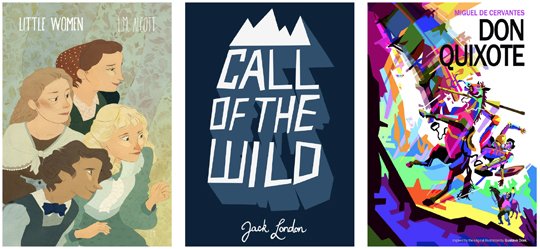The early editions of Bram Stoker’s 1897 horror novel, Dracula, feature covers that might seem, at least to modern eyes, a little understated given the macabre machinations of its vampire protagonist. One shows a plain red title on a muted yellow background. Another depicts a small garland of roses on an otherwise-empty beige background. And while we’ve all been told not to judge a book by its cover, sometimes it can be hard not to, especially with books that were published more than a century ago. Enter Recovering the Classics, a project launched in 2013 to crowdsource new cover designs for classic works of literature in the public domain, with the goal of reviving the canon for a new generation of readers.

Launched by two San Francisco–based companies, Recovering the Classics was born out of financial constraint. To entice people to sign up for DailyLit, a service that sends e-books to subscribers in daily installments, Jennifer 8. Lee—cofounder of DailyLit’s parent company, Plympton, a “literary studio that innovates in digital publishing” and is perhaps best known for helping launch the annual Twitter Fiction Festival—sought to add classic novels to its digital catalogue. But while many classics have entered the public domain, their cover art is still under copyright. “For three hundred covers, it was going to cost a hundred thousand dollars,” says Lee. “I thought, ‘Let’s make it into a movement.’”
So she reached out to the Creative Action Network (CAN), a consortium of graphic designers and artists that runs crowdsource campaigns to create art and design for social causes. CAN launched a campaign through which anyone can submit a newly designed cover for one of a hundred selected books—from Dante’s Inferno to Mary Shelley’s Frankenstein. The titles are only a fraction of the nearly 2.5 million books and periodicals available for free through the Digital Public Library of America (DPLA), a Boston-based nonprofit that shares the digitized contents of libraries nationwide. (Almost all titles published before 1923 are in the public domain; most books published thereafter are still copyrighted.) Lee estimates that only about two hundred fifty to three hundred fifty of those public-domain books are classics with mass appeal, and those are the books on which the project is focused. So far, over three hundred designers have made more than seven hundred fifty new covers.
These new creations are making appearances in the physical world as well. Bookstores that can print on demand, such as the Harvard Book Store in Cambridge, Massachusetts, use them when printing hard copies. This Side of Paradise and The Adventures of Sherlock Holmes, with updated covers, are stocked at stores of the popular eyewear designer Warby Parker throughout the country. And CAN sells products such as tote bags and T-shirts that use the cover art, with a portion of the proceeds going to the artists.
This year, Recovering the Classics has also teamed up with the White House initiative ConnectED, through which the government has pledged to provide $10 billion in digital-learning opportunities for American students. As part of the initiative, Recovering the Classics partnered with DPLA, the New York Public Library, the literacy nonprofit First Book, and book distributor Baker & Taylor to develop and populate an e-reading app, Open eBooks, that aims to provide free e-books to kids, particularly those from low-income areas. Released in February, the app features a selection of Recovering the Classics book covers that were voted on by the public, which the founders hope will draw young readers. “Kids at all income levels should have the same diversified access to books, because whim is the libido of reading,” says Dan Cohen, executive director of DPLA. “It’s wonderful to see a shelf and pick something off it, or to open a phone app and find something to read. That’s whim, and we should be able to do that in a fully digital environment.”
The Recovering the Classics organizers are looking to further expand the project’s reach with their new 50x50 campaign, which will present exhibitions of fifty cover posters in schools and libraries across the country by summer 2017. The team got the idea when they printed out a number of the book covers as posters for an exhibit at the American Library Association’s annual conference last June, and attendees kept asking if they could get copies of the posters to display in their libraries. “The answer was no,” Lee says, “but the question was so persistent I finally said, ‘Yes, you can do an exhibit! Not only that, we’re going to do it in all fifty states!’” Since many communities cannot afford large-format printing on this scale, Plympton and CAN launched a Kickstarter campaign, which raised more than $12,000 in two months.
Each school and library can create an exhibit in a different way, but Jody Chapel’s project at East High School in Denver last fall has so far served as the gold standard. Chapel, a visual-art teacher who worked as a graphic designer for twenty years, organized a school-wide project through which three hundred students designed their own book covers. She assigned books at random and asked students to research their books, create mood boards, and come up with two possible cover designs—much as it’s done in the industry. The best student covers, along with the professional ones, were displayed in the school library for one of the best-attended art openings in the school’s history. Selections of student covers were also displayed at Denver’s Tattered Cover Book Store and the Denver Public Library.
As this was an art class, Chapel didn’t require that students read the books, but she hopes that the assignment will plant a seed. “We’re so into getting students engaged in reading, using graphic novels and stories that connect to their lives, that many of these classic titles aren’t being emphasized anymore,” she says. “This project helped create a heightened awareness that the classics are still out there, waiting to be read.”
Jonathan Vatner is a fiction writer in Brooklyn, New York. He is the staff writer for Hue, the magazine of the Fashion Institute of Technology.








